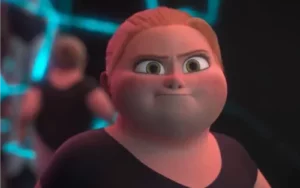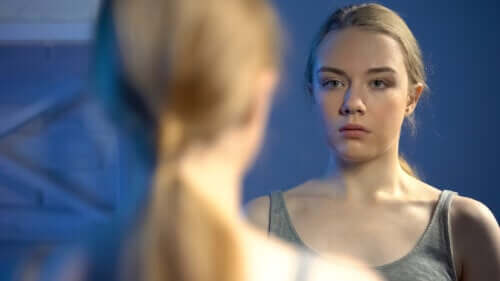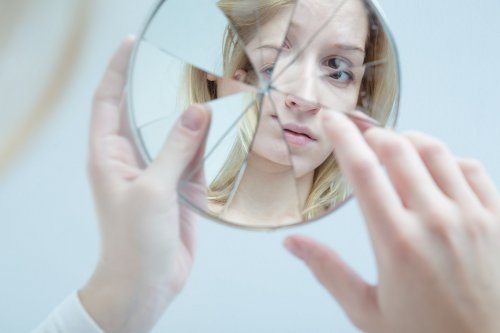Reflect, Disney's New Short Film About Body Dysmorphia


Written and verified by the psychologist Elena Sanz Martín
It is hard to believe that a child could be so concerned about their image that they could experience true suffering. Ideally, childhood should be a time of innocence and enjoyment in which a good foundation for self-esteem and mental health can be laid. But the truth is that a significant number of children have been found to have disorders related to physical appearance, such as body dysmorphia. Reflect, the new Disney short film, puts the spotlight on this problem.
Reflect is part of the Short Circuit Experimental Films, an innovative project through which anyone at Disney can submit their idea to be transformed into an animated short film. In this second season, and of all the films released, this is the one that most captures the public’s attention and generates more reflection and opinions.
Reflect, the battle with the mirror
This short film, which is available on the Disney+ streaming platform, was directed by Hillary Bardfield, who also participated in such acclaimed films as Frozen 2 (2019) and Encanto (2021). Reflect tells the story of Bianca, a young ballet dancer who battles against having a plus-size body. This isn’t easy in this society, but even less so in a world as demanding with the physical image as dance is.
In the images displayed in the film, we can see how the protagonist, despite how much she enjoys dancing, suffers when she looks at her reflection. When she looks at herself, the mirror cracks and plunges her into an anguishing and dark world from which she tries to escape without success. It’s a clear metaphor for the negative thoughts and emotions that accompany body dysmorphia.

Controversial opinions
Reflect has generated some controversy among viewers, leading to divided opinions. There are those who assume that the short film promotes obesity and an unhealthy lifestyle, so this isn’t a good example for children.
Also, there are those who consider that the fact that the protagonist has such a figure and that the story revolves around the problems faced by young people with non-normative bodies is a forced and unnecessary inclusion. But the truth is that the short film carries out important awareness-raising work that we shouldn’t overlook.
The visibilization of diversity
This animated short film stands out mainly for creating an overweight girl as the main character. In Disney, plus-size bodies are hardly represented and, if they appear, the character is a villain. Therefore, Bianca is the first to step out of this trajectory.
This helps greatly to make body diversity visible from childhood and to help children understand that we’re all different and valuable. In addition, Bianca can be a role model for many young boys and girls who suffer greatly from being out of the norm in terms of their physical appearance.
Raising awareness of body dysmorphia
Reflect also puts the spotlight on a disorder that’s not very well known, but whose prevalence has been on the rise in recent times. Body dysmorphia falls under the category of “obsessive-compulsive and related disorders”. That’s to say, it’s characterized by an excessive and persistent preoccupation with body image.
The sufferer of this disease has an altered perception of some part of their body that they consider ugly or unpleasant, deformed, or exaggerated. However, it’s actually within the limits of normality. Dysmorphia leads the person to constantly check their body in front of the mirror or to repeatedly compare themselves with others. They may also pinch the area they dislike and usually try to hide this perceived defect by all means.
The repercussions of this disorder are serious, as the sufferer spends a great deal of time worrying about their appearance, suffers significantly, and tends to isolate themselves. Therefore, personal, social, and academic life is affected. In addition, it’s common for other disorders such as anxiety or depression and even suicidal ideation to appear.

Reflect brings young people closer to a reality from which they must protect themselves
Body dysmorphia is a disorder that arises, most of the time, during adolescence. However, the sufferer is unaware that they’re ill and actually considers their defects to be exaggerated. Because of this, help usually isn’t sought in time.
Young people today are exposed to great risks by the media and social networks that promote unrealistic bodies and unattainable physical stereotypes. This can trigger self-esteem problems, eating disorders, body rejection, and disorders such as dysmorphia.
Therefore, audiovisual content that gives voice to these dangers and alerts us regarding how they can harm us is really valuable. Reflect is a different kind of film that should be watched as a family to reflect on and learn important lessons.
It is hard to believe that a child could be so concerned about their image that they could experience true suffering. Ideally, childhood should be a time of innocence and enjoyment in which a good foundation for self-esteem and mental health can be laid. But the truth is that a significant number of children have been found to have disorders related to physical appearance, such as body dysmorphia. Reflect, the new Disney short film, puts the spotlight on this problem.
Reflect is part of the Short Circuit Experimental Films, an innovative project through which anyone at Disney can submit their idea to be transformed into an animated short film. In this second season, and of all the films released, this is the one that most captures the public’s attention and generates more reflection and opinions.
Reflect, the battle with the mirror
This short film, which is available on the Disney+ streaming platform, was directed by Hillary Bardfield, who also participated in such acclaimed films as Frozen 2 (2019) and Encanto (2021). Reflect tells the story of Bianca, a young ballet dancer who battles against having a plus-size body. This isn’t easy in this society, but even less so in a world as demanding with the physical image as dance is.
In the images displayed in the film, we can see how the protagonist, despite how much she enjoys dancing, suffers when she looks at her reflection. When she looks at herself, the mirror cracks and plunges her into an anguishing and dark world from which she tries to escape without success. It’s a clear metaphor for the negative thoughts and emotions that accompany body dysmorphia.

Controversial opinions
Reflect has generated some controversy among viewers, leading to divided opinions. There are those who assume that the short film promotes obesity and an unhealthy lifestyle, so this isn’t a good example for children.
Also, there are those who consider that the fact that the protagonist has such a figure and that the story revolves around the problems faced by young people with non-normative bodies is a forced and unnecessary inclusion. But the truth is that the short film carries out important awareness-raising work that we shouldn’t overlook.
The visibilization of diversity
This animated short film stands out mainly for creating an overweight girl as the main character. In Disney, plus-size bodies are hardly represented and, if they appear, the character is a villain. Therefore, Bianca is the first to step out of this trajectory.
This helps greatly to make body diversity visible from childhood and to help children understand that we’re all different and valuable. In addition, Bianca can be a role model for many young boys and girls who suffer greatly from being out of the norm in terms of their physical appearance.
Raising awareness of body dysmorphia
Reflect also puts the spotlight on a disorder that’s not very well known, but whose prevalence has been on the rise in recent times. Body dysmorphia falls under the category of “obsessive-compulsive and related disorders”. That’s to say, it’s characterized by an excessive and persistent preoccupation with body image.
The sufferer of this disease has an altered perception of some part of their body that they consider ugly or unpleasant, deformed, or exaggerated. However, it’s actually within the limits of normality. Dysmorphia leads the person to constantly check their body in front of the mirror or to repeatedly compare themselves with others. They may also pinch the area they dislike and usually try to hide this perceived defect by all means.
The repercussions of this disorder are serious, as the sufferer spends a great deal of time worrying about their appearance, suffers significantly, and tends to isolate themselves. Therefore, personal, social, and academic life is affected. In addition, it’s common for other disorders such as anxiety or depression and even suicidal ideation to appear.

Reflect brings young people closer to a reality from which they must protect themselves
Body dysmorphia is a disorder that arises, most of the time, during adolescence. However, the sufferer is unaware that they’re ill and actually considers their defects to be exaggerated. Because of this, help usually isn’t sought in time.
Young people today are exposed to great risks by the media and social networks that promote unrealistic bodies and unattainable physical stereotypes. This can trigger self-esteem problems, eating disorders, body rejection, and disorders such as dysmorphia.
Therefore, audiovisual content that gives voice to these dangers and alerts us regarding how they can harm us is really valuable. Reflect is a different kind of film that should be watched as a family to reflect on and learn important lessons.
All cited sources were thoroughly reviewed by our team to ensure their quality, reliability, currency, and validity. The bibliography of this article was considered reliable and of academic or scientific accuracy.
- Salavert Jiménez, J., Clarabuch Vicent, A., & Trillo Garrigues, M. (2019). Trastorno Dismórfico Corporal: revisión sistemática de un trastorno propio de la adolescencia. Revista De Psiquiatría Infanto-Juvenil, 36(1), 4-19. https://doi.org/10.31766/revpsij.v36n1a1
- Janavel, A. (2022). Universidad de Belgrano. Influencia del uso de redes sociales en el desarrollo del trastorno dismórfico corporal en la adolescencia. Disponible en: http://repositorio.ub.edu.ar/handle/123456789/10069
- Rincón Barreto, D. M., Restrepo Escobar, S. M., Correa Pérez, L. F., Jorge Ospina Duque, J., & Montoya Arenas, D. A. (2020). Trastorno dismórfico corporal: una revisión de las dimensiones clínicas, neurobiología y neuropsicología. Cuadernos Hispanoamericanos De Psicología, 19(1), 1–16. https://doi.org/10.18270/chps.v19i1.3133
This text is provided for informational purposes only and does not replace consultation with a professional. If in doubt, consult your specialist.








